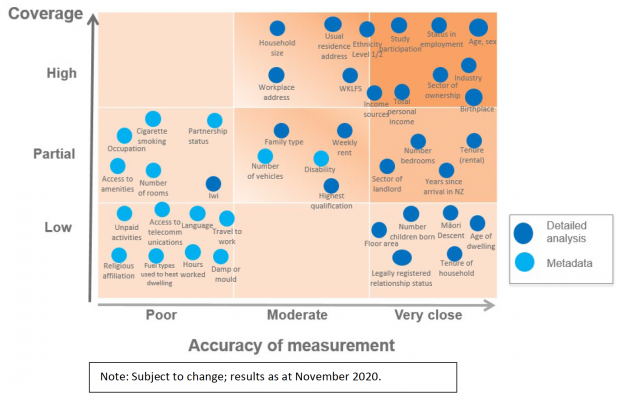A recent review of the administrative data (i.e. data from other government sources) used in New Zealand’s 2018 census has confirmed its value and revealed its potential. Penny takes a closer look at the strengths and weaknesses of admin data and how incremental changes by Stats NZ will ensure this data source will become even more useful in the future.
In the storm clouds created by low participation levels in the 2018 census, a silver lining glinted. A shiny thing called admin data.
Administrative data uses information on the respondent gathered from official, non-census datasets (e.g. health or education datasets). It was a breakthrough concept in the 2018 census allowing Stats NZ to move away from using modelled data (generated in imputation and other statistical approaches) to gathering real data about real people. Real is better … right?
Using admin sources data enabled Stats NZ to deliver data much higher confidence levels across many variables (though not all). We covered this topic in our NZ Census 2018 eBook. A reasonable next question for Stats NZ was “how can we make great use of admin data in the next census?”.
Answering that question, and others, was the basis for a recently released investigation by the Census Transformation Programme. The investigation focussed on the accuracy, measurement errors and representivity (i.e. were the right people or dwellings included in the data?) of admin data.
How far can admin data take us?
The investigation assesses the adequacy of admin data by variable. Many admin sources were found to provide a similar level of data to a census survey approach, but there are gaps: one in three variables are more accurate when gathered via a traditional survey method.
The following matrix is taken from the report and reveals the current accuracy of admin data if it was to be the only source used. It shows to variables such as age and sex have excellent coverage and are accurate, whereas variables that are typically “personal information that is unlikely to ever be captured well by government agencies”, such as religious affiliation and fuel types used in dwellings, have poor accuracy and coverage.
Figure 1. Accuracy and coverage of admin data (as the only source)

Source: “The quality of administrative data for census variables: Strengths, limitations, and opportunities”, Stats NZ Tatauranga Aotearoa, 2021
The matrix also reveals the problems when measuring variables. Some admin data sets might be extremely accurate but have poor coverage (e.g. those in the bottom right quadrant including housing tenure and relationship status).
There are several reasons for gaps in coverage. There can be an absence of digitised information – government datasets have only typically been converted since the late 1990s. An example of a gap would therefore be the birthplace and years in New Zealand for migrants who arrived before 1997.
In addition to lack of historical data, admin data does not capture events that occur overseas (such as academic qualifications, marriages or births).
Census data references a particular time to allow for longtitudinal data sets. Many admin data sets allow this, but there are exceptions – think time lags for address changes or tenancy bond changes.
Opportunities for improving adminstrative data
Ultimately the investigation into admin data confirmed its usefulness. There are numerous opportunities to reduce the current gaps.
To my mind, the most exciting is an experiment with an “Admin Population Census”, which would be an annual time-series. The annual approach will enable the incremental addition of admin datasets and facilitate a better understanding and improvements for quality issues.
Systemic changes will provide opportunities (e.g. from mid-2020 employees could report hours paid on their payroll returns and this could the “hours worked” variable).
A new statute, the Data and Statistics Bill, may pave the way to strengthening admin data. However, this Bill has been under discussion for several years.
Can we help?
id’s demographic experts are here to support Councils identifying and engaging with affected community cohorts. We offer training and advice to all subscribers of Community Profile and our other demographic tools, plus bespoke consulting for more complex needs.
If you work in Local Government and would like any assistance, contact us at demographics@id.com.au.










